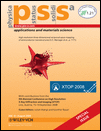In situ analysis of optoelectronic properties of dislocations in ZnO in TEM observations
Corresponding Author
Yutaka Ohno
Institute for Materials Research, Tohoku University, Sendai 980-8577, Japan
Phone: +81 22 215 2043, Fax: +81 22 215 2041Search for more papers by this authorToshinori Taishi
Institute for Materials Research, Tohoku University, Sendai 980-8577, Japan
Search for more papers by this authorIchiro Yonenaga
Institute for Materials Research, Tohoku University, Sendai 980-8577, Japan
Search for more papers by this authorCorresponding Author
Yutaka Ohno
Institute for Materials Research, Tohoku University, Sendai 980-8577, Japan
Phone: +81 22 215 2043, Fax: +81 22 215 2041Search for more papers by this authorToshinori Taishi
Institute for Materials Research, Tohoku University, Sendai 980-8577, Japan
Search for more papers by this authorIchiro Yonenaga
Institute for Materials Research, Tohoku University, Sendai 980-8577, Japan
Search for more papers by this authorAbstract
Extended defects acting as non-radiative recombination center or those acting as radiative one were, respectively, studied by transmission electron microscopy under the illumination of a monochromatic light or cathodoluminescence spectroscopy combined with light illumination. By means of this method, defect levels associated with dislocations in ZnO, which were introduced at elevated temperatures above 923 K, were determined. It was proposed that (i) a screw dislocation, presumably acting as non-radiative recombination center, glides under the illumination of a light with photon energy above 2.48–2.61 eV, due to an electron–hole recombination at a defect level of 2.48–2.61 eV depth, and (ii) a mixed dislocation acts as radiative recombination center with a defect level of 3.1 eV depth.
References
- 1 E. Muller, D. Gerthsen, P. Bruckner, F. Scholz, Th. Gruber, and A. Waag, Phys. Rev. B 73, 245316 (2006).
- 2 D. Cherns and C. G. Jiao, Phys. Rev. Lett. 87, 205504 (2001).
- 3 P. Ebert, C. Domke, and K. Urban, Appl. Phys. Lett. 78, 480 (2001).
- 4 P. J. Hansen, Y. E. Strausser, A. N. Erickson, E. J. Tarsa, P. Kozodoy, E. G. Brazel, J. P. Ibbetson, U. Mishra, V. Narayanamurti, S. P. DenBaars, and J. S. Speck, Appl. Phys. Lett. 72, 2247 (1998).
- 5 J. Kikkawa, S. Takeda, Y. Sato, and M. Terauchi, Phys. Rev. B 75, 245317 (2007).
- 6 A. Galeckas, J. Linnros, and P. Pirouz, Appl. Phys. Lett. 81, 883 (2002).
- 7 J. Schreiber, U. Hilpert, L. Horing, L. Worschech, B. Konig, W. Ossau, A. Waag, and G. Landwehr, Phys. Status Solidi B 222, 169 (2000).
- 8 U. Hilpert, J. Schreiber, L. Worschech, L. Horing, M. Ramsteiner, W. Ossau, and G. Landwehr, J. Phys.: Condens. Matter 12, 10169 (2000).
- 9 J. Kasai and M. Kawata, Appl. Phys. Lett. 73, 2012 (1998).
- 10 Y. Ohno and S. Takeda, Rev. Sci. Instrum. 66, 4866 (1995).
- 11 Y. Ohno, Appl. Phys. Lett. 87, 181909 (2005).
- 12 K. Maeda, K. Suzuki, Y. Yamashita, and Y. Mera, J. Phys.: Condens. Matter 12, 10079 (2000).
- 13 I. Yonenaga, J. Appl. Phys. 84, 4209 (1998).
- 14 S. Lavagne, C. Levade, and G. Vanderschaeve, Inst. Phys. Conf. Ser. 169, 219 (2001).
- 15 Y. G. Shreter, Y. T. Rebane, O. V. Klyavin, P. S. Aplin, C. J. Axon, W. T. Young, and J. W. Steeds, J. Cryst. Growth 159, 883 (1996).
- 16 Y. Ohno, Springer Proc. Phys. 107, 507 (2005).
- 17 M. A. Razumova and V. M. Khotyaintsev, Phys. Status Solidi B 210, 791 (1998).
- 18 R. W. Nunes, J. Bennetto, and D. Vanderbilt, Phys. Rev. Lett. 77, 1516 (1996).
- 19 A. Setiawan, Z. Vashaei, M. W. Cho, T. Yao, H. Kato, M. Sano, K. Miyamoto, I. Yonenaga, and H. J. Ko, J. Appl. Phys. 96, 3763 (2004).
- 20 I. Yonenaga, H. Koizumi, T. Taishi, and Y. Ohno, J. Appl. Phys. 103, 093502 (2008).
- 21 Y. Ohno, H. Koizumi, T. Taishi, I. Yonenaga, K. Fujii, H. Goto, and T. Yao, J. Appl. Phys. 104, 073515 (2008).
- 22 Y. Ohno, H. Koizumi, T. Taishi, I. Yonenaga, K. Fujii, H. Goto, and T. Yao, Appl. Phys. Lett. 92, 011922 (2008).
- 23 U. Ozgur, Y. I. Alivov, C. Liu, A. Teke, M. A. Reshchikov, S. Doian, V. Avrutin, S. J. Cho, and H. Morkoc, J. Appl. Phys. 98, 041301 (2005).
- 24 Q. X. Zhao, P. Klason, M. Willander, H. M. Zhong, W. Lu, and J. H. Yang, Appl. Phys. Lett. 87, 211912 (2005).
- 25 D. R. Locker and J. M. Meese, IEEE Trans. 19, 237 (1972).
- 26 N. Yamamoto, H. Itoh, V. Grillo, S. F. Chichibu, S. Keller, J. S. Spence, S. P. DenBaars, U. K. Mishra, S. Nakamura, and G. Salviati, J. Appl. Phys. 94, 4315 (2003).
- 27 M. Albrecht, H. P. Strunk, J. L. Weyher, I. Grzegory, S. Porowski, and T. Wosinski, J. Appl. Phys. 92, 2000 (2002).
- 28 V. A. Coleman, J. E. Bradby, C. Jagadish, and M. R. Phillips, Appl. Phys. Lett. 89, 082102 (2006).
- 29 Z. Takkouk, N. Brihi, K. Guergouri, and Y. Marfaing, Physica B 366, 185 (2005).
- 30 J. E. Bradby, S. O. Kucheyev, J. S. Williams, C. Jagadish, M. V. Swain, P. Munroe, and M. R. Phillips, Appl. Phys. Lett. 80, 4537 (2002).
- 31 I. Yonenaga, H. Makino, S. Itoh, T. Goto, and T. Yao, J. Electron. Mater. 35, 717 (2006).
- 32 S. O. Kucheyev, J. E. Bradby, J. S. Williams, C. Jagadish, M. Toth, M. R. Phillips, M. V. Swain, Appl. Phys. Lett. 77, 3373 (2000).
- 33 L. Carlson and C. Svensson, Solid State Commun. 7, 177 (1969).
- 34 M. J. Klopfstein, D. A. Lucca, and G. Cantwell, Phys. Status Solidi A 196, R1 (2003).




